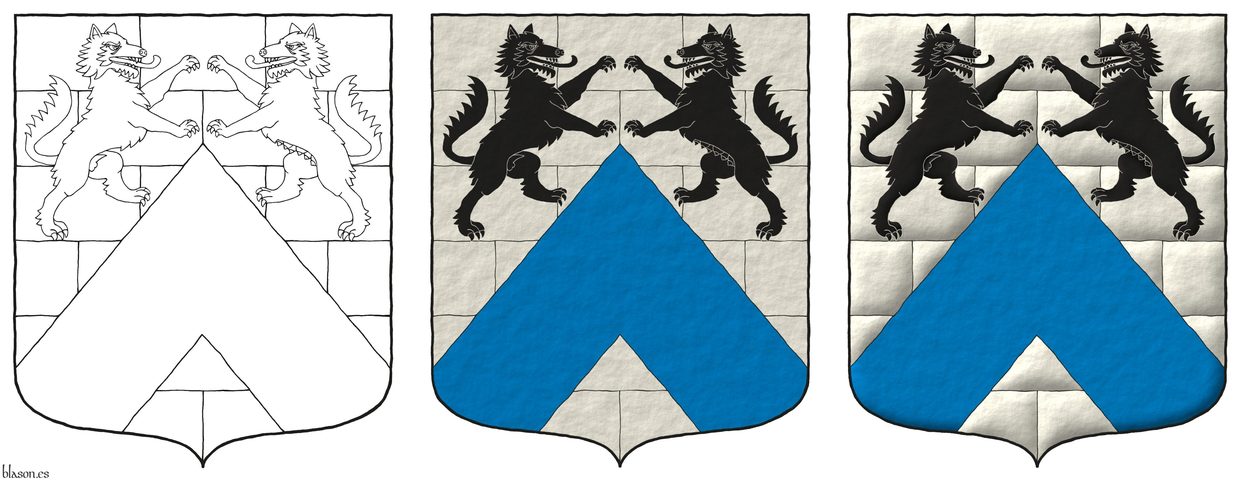Combatant


Richard I of England
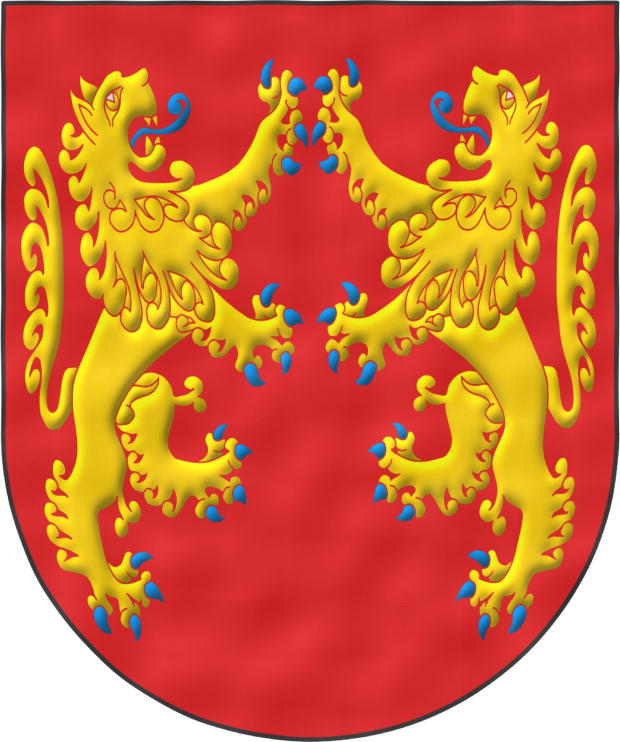
Lionheart ~ Corazón de León ~ Cœur de Lion.
Escudo de gules, dos leones de oro, afrontados, armados y lampasados de azur.
Coat of arms interpreted as follows: the mouth drawn as a semicircular (round) base; the field enamelled in a flat tint of Gules; the two lions outlined in the colour of the field and illuminated in Or and Azure; and the whole finished with a watercolour effect.
He was born in 1157, being the third of eight children of Henry II of England and Eleanor of Aquitaine, elder brother of Eleanor Plantagenet. He was king of England between 1189 and 1199, although he spent much of his life far from it; in fact, during his ten-year reign, he was on English soil only twice, which together did not amount even to six months. He died in 1199 in Normandy.
In 1198, during the Battle of Gisors, he supposedly used, as watchword or as motto, the expression «Dieu et mon Droit ~ God and my right». This phrase refers to his refusal to bow before Emperor Henry VI, since by his rank Richard acknowledged only God as superior. Later, Henry V of England adopted it as his motto, and since then it has been used by the British monarchy.
According to [Humphery-Smith, C.; 1983], Richard the Lionheart was the first English king who can be proved to have borne arms, although some of his predecessors may also have had them. He bases his statement on the existence of two seals of Richard I: on one, Richard bears a shield with a rampant lion, and on the other there already appear the three lions that are the forerunners of the arms of England. The use of this second seal does not imply that he stopped using the first.
In contrast, there are also British authors who maintain that his shield actually bore two affronted lions; this hypothesis is based on the lion on his first seal facing to sinister. That latter hypothesis is the one interpreted in this shield, remaining a purely artistic interpretation and without my entering into a complex and open discussion about how, when, and why the three leopards, «leones pasantes ~ lions passant» for the English, appeared —a discussion in which there are various alternatives— ranging from the combination of his hereditary arms to the wish to have more lions than his younger brother, who would later be King John I of England, to possible influences from other European realms.
This version of Richard I’s shield is similar to the imaginary shield of Hector of Troy, Gules with two lions Or affronté, which is a term used when «two things are placed facing each other, like two Lions, two Dogs, or other animals that look at one another» [Avilés, J.; 1725a; page 32].
Blazon keywords: Without divisions, Gules, Lion, Or, Combatant, Armed, Langued and Azure.
Style keywords: Semi-circular, Illuminated, Outlined in sable and Freehand.
Classification: Interpreted, Personal, Coat of arms, House of Plantagenet and Kingdom of England.
Bearer: Richard I of England.


Romanet, Catherine de
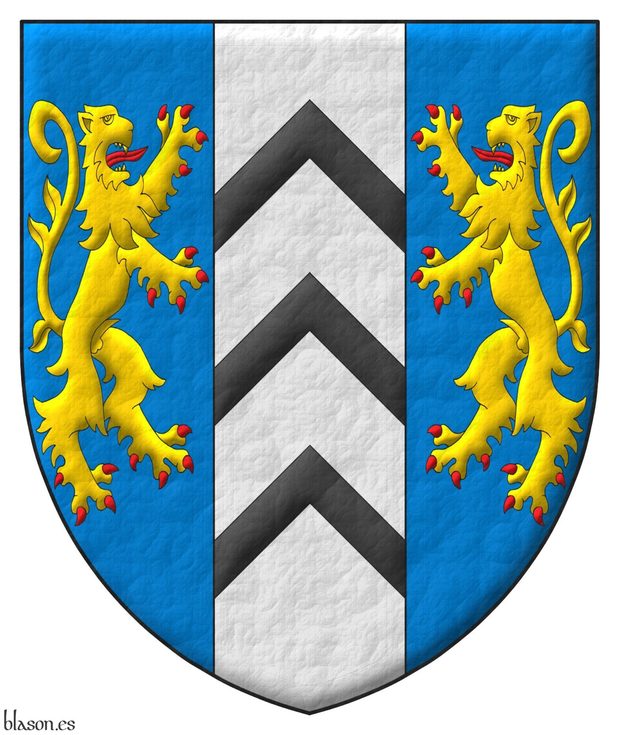
Azure, on a pale Argent, between two lions combatant Or, armed and langued Gules, three chevronels Sable.
Escudo de azur, un palo de plata, cargado de tres tenazas de sable, acostado de dos leones afrontados de oro, armados y lampasados de gules.
Arms depicted by me, illuminated with lights and shadows, contoured in Sable, with a pointed outer contour and with a leather finishing.
The coat of arms of Catherine de Romanet emblazoned by me. Blazon in French: «D'azur, au pal d'argent chargé de trois chevrons de sable et accosté de deux lions affrontés d'or, armés et lampassés de gueules». Alternative blazon: «Azure, a pale Argent, charged with three chevronels Sable, between two lions combatant Or, armed and langued Gules».
Blazon keywords: Azure, Argent, Sable, Or, Gules, One, Three, Two, Pale, Charged, Chevronel, Between, Lion, Combatant, Armed and Langued.
Style keywords: Outlined in sable, Illuminated, Pointed and Leather.
Classification: Personal, Interpreted, Boa and Coat of arms.
Bearer: Romanet, Catherine de.


Juan Lanzagorta Vallín, schema 1x3
Argent masoned Sable, a chevron Azure, in chief a wolf and a she-wolf combatant Sable.
Coat of arms of Juan Lanzagorta Vallin designed by him and outlined by me. The image illustrates my working process in 3 steps: 1) outlined, 2) flat colors and metal, and 3) lights and shadows. I have never painted a field masoned sable. The chevron Azure symbolizes the firmament seen through an open hole in the masoned wall, like a window open to the sky.
Credits: Juan Lanzagorta Vallin is the designer of the coat of arms.
Blazon keywords: Azure, Argent, Sable, One, Two, Masoned, Chevron, In chief, Wolf, She-wolf and Combatant.
Style keywords: Outlined, Outlined in sable, Plain tincture, Illuminated and Ogee.
Classification: Personal, Interpreted, Schema, Boa and Coat of arms.
Bearer: Lanzagorta Vallín, Juan.


Juan Lanzagorta Vallín, outlined
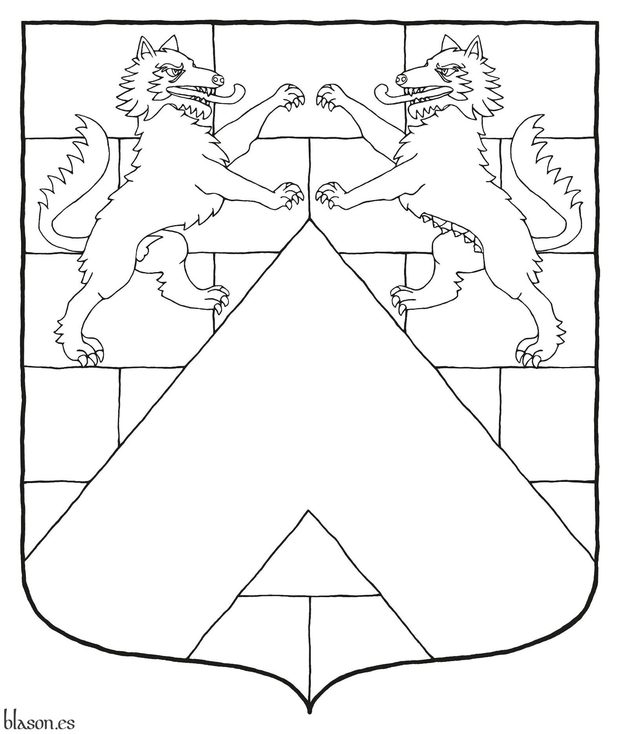
Argent masoned Sable, a chevron Azure, in chief a wolf and a she-wolf combatant Sable.
Coat of arms of Juan Lanzagorta Vallin designed by him and outlined by me.
Credits: Juan Lanzagorta Vallin is the designer of the coat of arms.
Blazon keywords: Azure, Argent, Sable, One, Two, Masoned, Chevron, In chief, Wolf, She-wolf and Combatant.
Style keywords: Outlined and Ogee.
Classification: Personal, Interpreted, Boa and Coat of arms.
Bearer: Lanzagorta Vallín, Juan.


Juan Lanzagorta Vallín
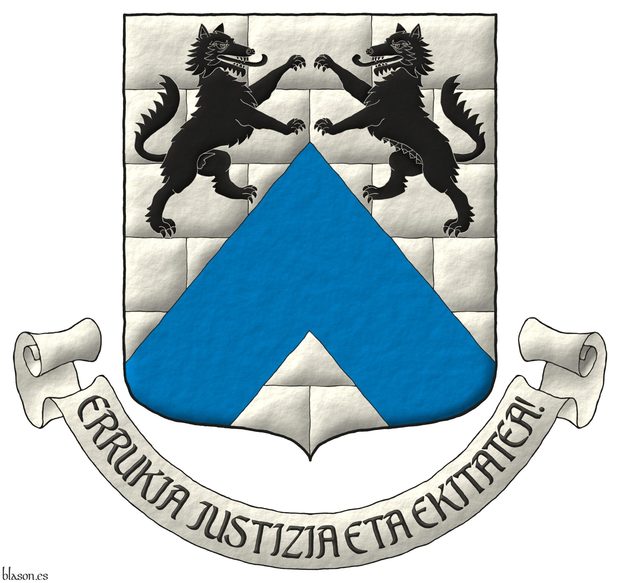
Argent masoned Sable, a chevron Azure, in chief a wolf and a she-wolf combatant Sable. Motto: «Errukia justizia eta ekitatea!».
Escudo de plata mazonado de sable, un cabrio de azur, en jefe un lobo y una loba afrontados de sable. Lema: «Errukia justizia eta ekitatea!».
Coat of arms interpreted by me, outlined in Sable, with an ogee external shape and with a freehand finish.
Coat of arms of Juan Lanzagorta Vallin designed by him and emblazoned by me. I have never painted a field masoned sable. The chevron Azure symbolizes the firmament seen through an open hole in the masoned wall, like a window open to the sky.
Credits: Juan Lanzagorta Vallin is the designer of the coat of arms.
Blazon keywords: Azure, Argent, Sable, One, Two, Masoned, Chevron, In chief, Wolf, She-wolf, Combatant and Motto.
Style keywords: Outlined in sable, Ogee and Freehand.
Classification: Personal, Interpreted, Boa and Coat of arms.
Bearer: Lanzagorta Vallín, Juan.
-
Language
-
Categories of heraldry
-
Divisions of the field
- Without divisions
- Party per pale
- Party per fess
- Party per bend
- Party per bend sinister
- Tierce
- Tierce sinister
- Tierced per fess
- Tierced per bend
- Tierced pallwise inverted
- Quarterly
- Quarterly per saltire
- Gyronny
- Party per fess, the chief per pale
- Party per pale, the sinister per fess
- Party per fess, the base per pale
- Party per pale, the dexter per fess
- Chapé
- Chaussé
- Party per chevron
- Enté en point
- Flanched
-
Metals
-
Colours
-
Furs
-
Other tinctures
-
Ordinaries and sub-ordinaries
-
Diminutives of the ordinaries
-
Other charges
-
Charges from Nature
Water, Eagle, Bald eagle, Eagle claw, Dorsal fin, Tail fin, Two hands clasped, Lark, Tree, Trunk, Rainbow, Atom, Barbel, Acorn, Bighorn sheep, Arm, Owl, Vulture, Horse, Head, Goat, Camellia, Thistle, Merino ram, Kapok tree, Stag, Doe, Crescent, Increscent, Chrysanthemum, Tail, Tail addorsed, Ermine spot, Hummingbird, Snowflake, Heart, Roe deer, Neck, Roe deers' attires, Raven, Dolphin, Diamond, Tooth, Elephant, Emerald, Starling, Mullet, Mullet of four points, Star of David, Estoile, Male figure, Fleur de lis, Flower, Cornflower, Dogwood flower, Lotus flower, Hop cone, Bluebonnet, Puffin, Ash, Rooster, Claw, Talon, Goose, Heron, Seagull, Pomegranate, Sunflower, Swallow-tail, Falcon, Leaf, Boar, Goldfinch, Laurel, Barn owl, Lion, Lioness, Lion passant, Leopard, Lion rampant guardant, Lynx, Lily, Madonna lily, Flame, Wolf, She-wolf, Parrot, Moon, Hand, Apple, Apple tree, Martlet, Wing, Two wings in vol, Covert, Blackbird, Mount, Trimount, Fly, Wrist, Elm, Olive tree, Orbital, Bear, Palm frond, Palm tree, Dove, Poplar leaf, Panther, Jaguar, Vine, Paw, Forepaw, Foot (palmiped), Foreleg, Peacock, Chest, Pelican, Pelican in her piety, Dog, Brach hound, Warren hound, Fish, Hoof, Beak, Quill, Cinquefoil, Quetzal, Branch, Sprig, Frog, Shamrock, Caboshed, Oak, Holm oak, Rose, Double rose, Savage, Serpent, Plough of Ursa Major, Sun, Sun in splendour, Ray of the sun, Lightning flash, Stem, Badger, Tyger, Linden, Wheat, Wheat spike, Bull, Tulip, Udder, Escallop and Fox.
-
Artificial charges
Halberd, Plough share, Ace of spades, Anchor, Cyclamor, Torch, Bow, Arch, Harp, Non-classic artifact, Winnowing fan, Crozier, Conductor's baton, Pair of scales, Ship, Norman ship, Beret, Grenade, Ecclesiastical cap, Arm vambraced, Knight, Chain, Covered cup, Monstrance, Bell, Bell tower, Cannon dismounted, Carbuncle, Castle, Ribbon, Clarion, Nail, Cord, Dagger, Key ward, Turret, With a turret, Armillary sphere, Sword, Federschwert, Sabre, Parchment, Scroll, Arrow, Club, Garb, Sheaf of tobacco, Scythe, Gauntlet, Axe, Buckle, Galician granary, Polish winged hussar, Church, Oil lamp, Spear, Spear's head, Fleam, Letter, Book, Open book, Closed book, Bookmark, Page, Line, Lantern, Key, Four crescents joined millsailwise, Hammer, Menorah, Mortar, Pestle, Number, Knot, Celtic Trinity knot, Water-bouget, Comb, Piano, Millstone, Millrind, Millwheel, Clay pot, Bridge, Cuffed, Hourglass, Chess rooks, Compass rose, Rosette of acanthus leaves, Mullet of six points pierced, Broken, Portcullis, Wheel, Wagon-wheel, Symbol, Sackbut, Drum, Geometric solid, Tetrahedron, Tower, Trident, Trumpet, Double vajra and Anvil.
-
Immaterial charges
Angel, Archangel, Heart enflamed, Sacred Heart of Jesus, Paschal lamb, Dragon, Wyvern, Phoenix, Garuda, Griffin, Sea-griffin, Winged hand, Our Lady of Mercy, Pegasus, Saint George, Mermaid, Trinity, Triton, Golden fleece, Unicorn and Ouroboros.
-
External elements
-
Heraldic creations
-
References
-
Formats
-
Keywords on this page
Between, Combatant, Pointed, Armed, Azure, Boa, Chevron, Charged, House of Plantagenet, Ogee, Outlined, Outlined in sable, Two, In chief, Coat of arms, Schema, Personal, Gules, Illuminated, Interpreted, Langued, Lanzagorta Vallín, Juan, Motto, Lion, She-wolf, Wolf, Masoned, Semi-circular, Or, Pale, Leather, Argent, Without divisions, Kingdom of England, Richard I of England, Romanet, Catherine de, Sable, Chevronel, Plain tincture, Freehand, Three and One.
